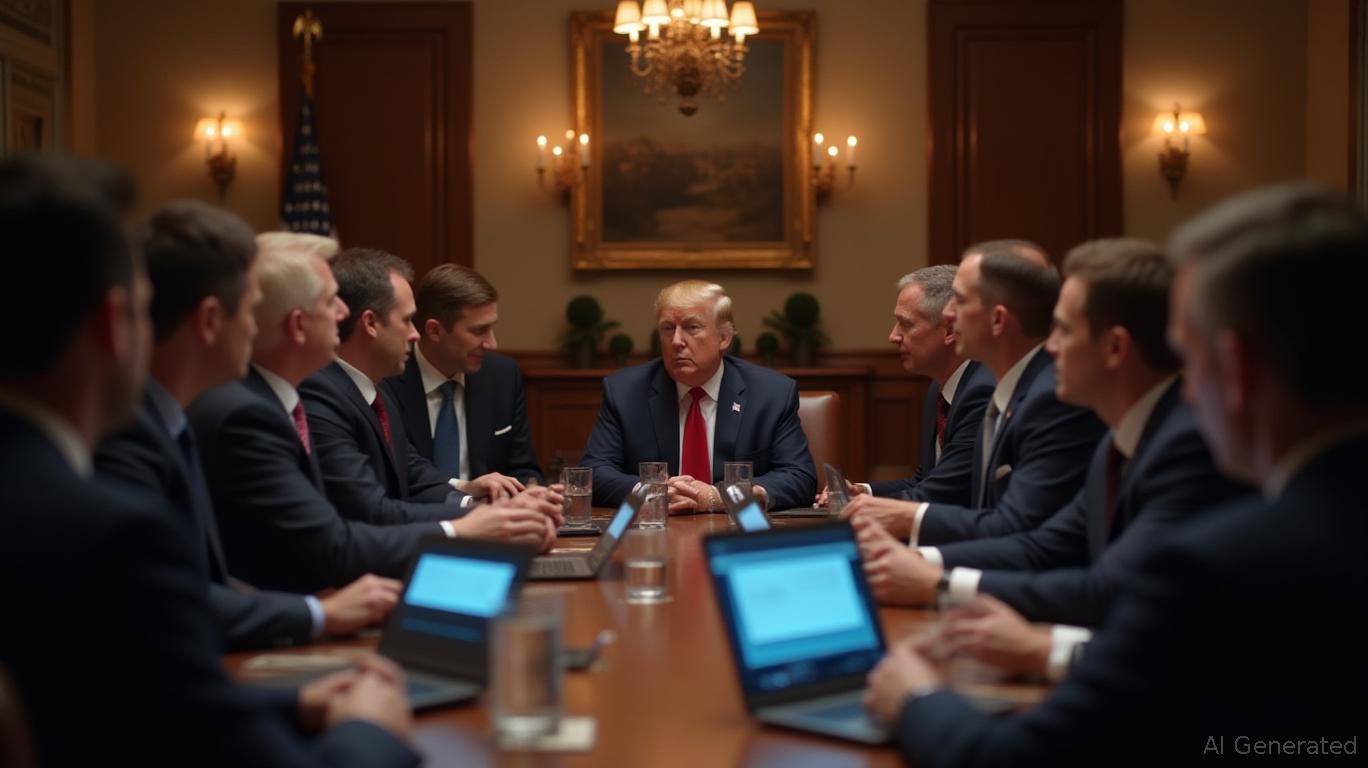XRP News Update: Silicon Valley and Crypto Investors Back Trump’s Ballroom in Support of Pro-Digital Policies
- Trump's $300M White House ballroom, funded by crypto firms and Big Tech, sparks debates over corporate influence and transparency in political donations. - Ripple, Tether, Coinbase, and YouTube (via $22M) join Amazon/Google/Meta in backing the project, signaling crypto/tech sector's strategic alignment with Trump's pro-digital policies. - Critics argue donor recognition (plaques) blurs ethical lines, while preservationists warn the 90,000-sq-ft addition risks damaging the White House's historic design. -
President Donald Trump's initiative to build a privately funded ballroom at the White House has attracted widespread attention, not only due to the project's magnitude but also because of its diverse group of donors, which includes leading cryptocurrency companies and major technology corporations. According to White House representatives, the $300 million project—which will see a portion of the East Wing demolished to make way for a 90,000-square-foot ballroom—is being paid for entirely through private contributions and the president's own resources. The participation of firms such as Ripple,
This undertaking has become a symbol of the cryptocurrency sector’s increasing alignment with the Trump administration. Executives from Ripple, Coinbase, and Tether were present at a prominent fundraising event for the ballroom, highlighting the digital asset industry’s efforts to build relationships with government officials. Ripple’s involvement, in particular, signals its growing influence in Washington, following previous record-breaking donations to Trump’s inauguration, as noted by

Major technology companies have also made notable contributions. Amazon, Apple, Google, Microsoft, and Meta are among the donors, with Alphabet’s $22 million donation reportedly linked to a settlement that resolved Trump’s lawsuit over his YouTube account suspension after January 6, 2021, as reported by
The scale of the ballroom has drawn criticism from preservationists and historians, who caution that such a large addition could compromise the White House’s historic architecture. The National Trust for Historic Preservation has requested a public review, arguing that the project "could irreversibly alter the carefully balanced classical design" of the residence, the
Political commentators interpret the project as a calculated effort by the crypto industry to strengthen its relationship with an administration supportive of digital assets. Trump’s recent pardons of crypto figures, such as Binance’s Changpeng Zhao, and his appointment of a pro-crypto SEC chair have already shifted the regulatory landscape. With a new market structure bill close to completion, industry leaders expect even more favorable policies, as previously mentioned by Crypto.News. Still, the direct financial involvement of crypto companies in a White House project marks a significant shift from traditional lobbying, prompting concerns about influence and responsibility, as earlier highlighted by Coin Edition.
As the ballroom approaches its expected completion in 2029, debates about its impact on governance and the relationship between corporations and politics are set to grow. For now, the project highlights the changing balance of power among Silicon Valley, Wall Street, and the White House.
Disclaimer: The content of this article solely reflects the author's opinion and does not represent the platform in any capacity. This article is not intended to serve as a reference for making investment decisions.
You may also like
Can the biggest Bitcoin whales really decide when the market turns green or red?
Bitcoin News Update: Wall Street's Crypto Strategy: JPMorgan's Collateral Decision Stirs Friction with Traditional Systems
- JPMorgan will let institutional clients use Bitcoin and Ethereum as loan collateral by year-end, advancing digital asset integration in traditional finance. - Major banks like Morgan Stanley and Fidelity are expanding crypto offerings, reflecting rising institutional demand for digital assets. - JPMorgan’s CEO, Jamie Dimon, now permits BTC purchases but avoids custody, while volatility and rehypothecation risks persist. - Swiss and U.S. banks, including Goldman Sachs, are adopting crypto-collateralized l

Ethereum Updates: Crypto Miners Move to Cloud Solutions Amid Increasing Expenses and Regulatory Pressures
- ETC mining gains traction as XRP/BTC/ETH holders seek passive income via cloud platforms like LTCCloudMining. - LTCCloudMining offers $0.7/day returns, multi-coin support (XRP/BTC/ETH/SOL), and a 5% affiliate bonus cap of $100,000. - Rising XRP volatility and ETF expectations drive demand for diversified cloud mining to hedge market risks. - Cloud mining addresses high costs and regulatory pressures through no-contract models and global accessibility.

ALT5 Sigma Faces Leadership Crisis, Putting Crypto Plans at Risk While ALTS Jump 9.9%
- ALT5 Sigma's abrupt CEO removal and CFO appointment drove ALTS stock up 9.9%, raising governance concerns over its $1.5B WLFI acquisition plan. - The leadership turmoil threatens execution of its crypto strategy, as regulatory uncertainty and WLFI's Trump-family ties amplify market skepticism. - Broader crypto optimism emerged from Australia's 31% adoption rate and VCI Global's Ethereum-based platform, signaling maturing institutional integration. - Trump's pardon of Binance CEO Zhao further highlighted
